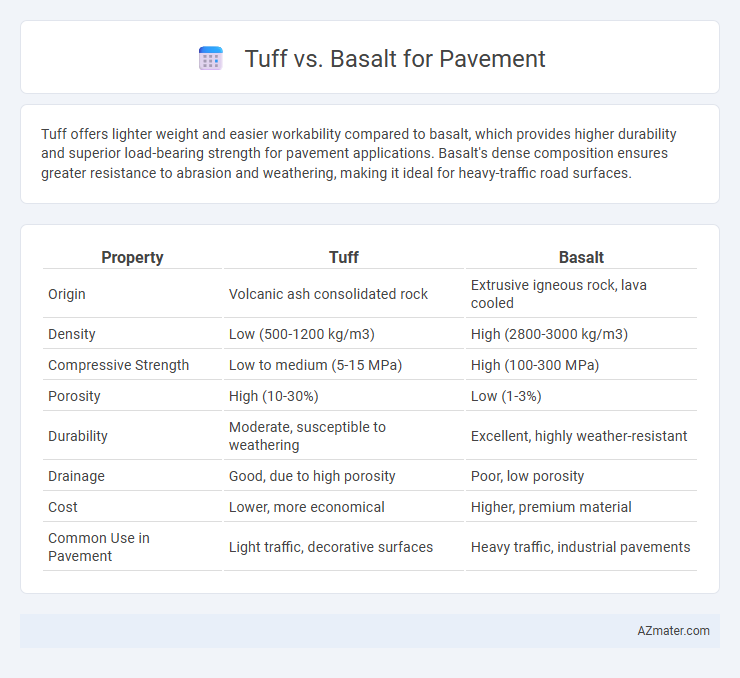Tuff offers lighter weight and easier workability compared to basalt, which provides higher durability and superior load-bearing strength for pavement applications. Basalt's dense composition ensures greater resistance to abrasion and weathering, making it ideal for heavy-traffic road surfaces.
Table of Comparison
| Property | Tuff | Basalt |
|---|---|---|
| Origin | Volcanic ash consolidated rock | Extrusive igneous rock, lava cooled |
| Density | Low (500-1200 kg/m3) | High (2800-3000 kg/m3) |
| Compressive Strength | Low to medium (5-15 MPa) | High (100-300 MPa) |
| Porosity | High (10-30%) | Low (1-3%) |
| Durability | Moderate, susceptible to weathering | Excellent, highly weather-resistant |
| Drainage | Good, due to high porosity | Poor, low porosity |
| Cost | Lower, more economical | Higher, premium material |
| Common Use in Pavement | Light traffic, decorative surfaces | Heavy traffic, industrial pavements |
Introduction: Tuff vs Basalt for Pavement
Tuff and basalt are two volcanic rocks commonly used in pavement construction, each offering distinct physical properties and durability. Basalt is known for its high density, hardness, and abrasion resistance, making it ideal for heavy traffic roads and long-lasting surfaces. Tuff, being lighter and more porous, provides better insulation and is easier to cut but generally requires sealing to enhance its durability in pavement applications.
Geological Origins of Tuff and Basalt
Tuff is a volcanic rock formed from consolidated volcanic ash ejected during explosive eruptions, characterized by its porous texture and relatively low density. Basalt originates from the rapid cooling of basaltic lava flows, resulting in a dense, fine-grained igneous rock known for its high durability and strength. The distinct geological formation processes of tuff and basalt influence their physical properties and suitability for pavement applications.
Physical Properties Comparison
Tuff exhibits lower density and compressive strength compared to basalt, making it less suitable for high-traffic pavements requiring durability. Basalt's superior hardness and abrasion resistance contribute to better load-bearing capacity and longevity in pavement applications. The porosity of tuff leads to higher water absorption, potentially compromising pavement stability, whereas basalt's low porosity enhances resistance to weathering and freeze-thaw cycles.
Durability and Weather Resistance
Basalt is highly valued for pavement due to its superior durability and exceptional weather resistance, maintaining structural integrity under heavy traffic and extreme climatic conditions. Tuff, while lighter and easier to quarry, generally exhibits lower strength and is more porous, leading to accelerated wear and susceptibility to freeze-thaw cycles. Engineering projects demanding long-term pavement performance typically prefer basalt for its dense composition and resilience against abrasion and weathering.
Load-Bearing Capacity
Basalt exhibits higher load-bearing capacity compared to tuff due to its greater density and compressive strength, making it more suitable for heavy-duty pavement applications. Tuff, being a porous volcanic rock, has lower durability and strength, limiting its effectiveness under heavy traffic loads. Engineers prefer basalt for pavement construction where sustained load stress and long lifespan are critical factors.
Workability and Installation Ease
Tuff offers superior workability for pavement due to its softer texture, allowing easier cutting, shaping, and installation compared to basalt's dense and hard composition. Basalt's high durability requires more specialized tools and labor for installation, increasing time and effort on-site. Choosing tuff can significantly reduce construction complexity and accelerate the pavement laying process.
Cost Evaluation and Availability
Tuff generally offers a cost-effective solution for pavement due to its widespread availability and ease of extraction, resulting in lower transportation and processing expenses compared to basalt. Basalt, while more expensive, provides superior durability and load-bearing capacity, which may reduce long-term maintenance costs despite higher initial investment. Regional availability significantly influences the cost evaluation, as areas rich in basalt deposits typically have balanced pricing, whereas imported basalt increases expenses relative to locally sourced tuff.
Environmental Impact and Sustainability
Basalt pavement offers superior environmental benefits due to its natural abundance, high durability, and low maintenance requirements, resulting in reduced resource consumption and longer lifespan compared to tuff. Tuff, while lighter and easier to quarry, often requires more frequent replacement and treatment, increasing its overall environmental footprint. Sustainable construction practices favor basalt for pavement because its longevity minimizes carbon emissions associated with repair and replacement activities.
Maintenance Requirements and Longevity
Basalt pavement offers superior durability and lower maintenance requirements due to its high compressive strength and resistance to weathering and abrasion, making it ideal for heavy traffic conditions. Tuff, being more porous and less dense, tends to wear faster and may require more frequent repairs and sealing to prevent surface degradation. Over time, basalt pavements exhibit greater longevity, often exceeding several decades, whereas tuff pavements may experience reduced lifespan under similar stress conditions.
Best Applications: Choosing Between Tuff and Basalt for Pavements
Tuff's porous and lightweight nature makes it ideal for pavements requiring enhanced drainage and thermal insulation, such as pedestrian walkways and low-traffic urban areas. Basalt's high density, durability, and resistance to abrasion suit heavy-load roads, highways, and industrial pavement applications where strength and longevity are critical. Selecting between tuff and basalt depends on load requirements, environmental exposure, and maintenance needs to optimize pavement performance and lifespan.

Infographic: Tuff vs Basalt for Pavement
 azmater.com
azmater.com